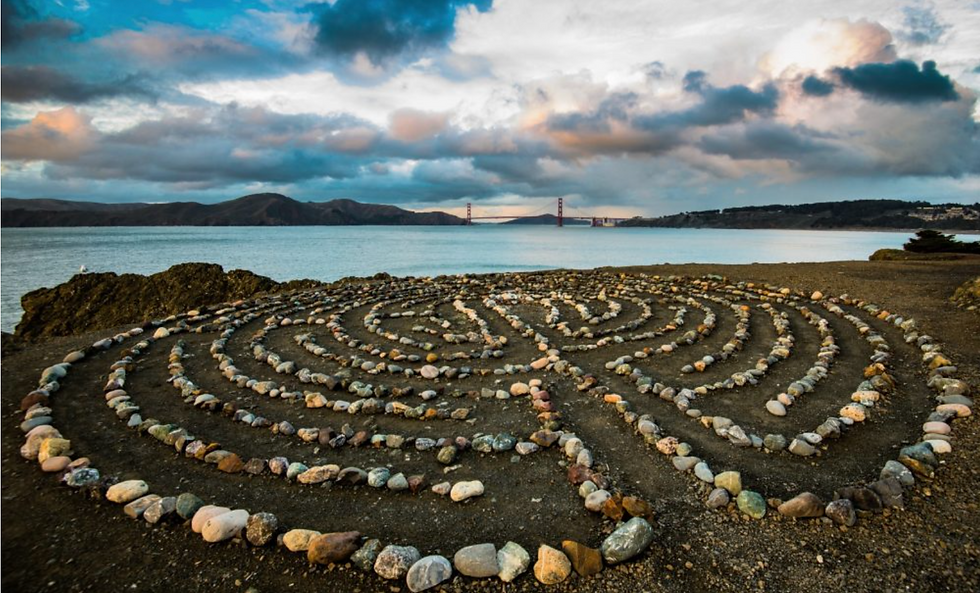LABYRINTHS: A WALK ON THE WILD SIDE
- Riccardo Aimerito
- Jan 7, 2021
- 3 min read
He enters a labyrinth, and multiplies a thousandfold the dangers that life in itself brings with it.” - Frederich Nietzsche, Beyond Good and Evil
According to Greek mythology, the labyrinth was designed by Daedalus for King Minos of Crete in order to detain the monster Minotaur. In the Middle Ages, it was related to one’s spirituality by walking with faith, no matter what obstacles life brought you. While a labyrinth can be compared to a type of maze, its purpose is much different. Labyrinths are often flat and structured with rocks, forming a circle with a single path that leads to the center. Mazes were built to confuse the traveler with multiple choices often leading to dead-ends; while a labyrinth’s function is to initiate a mindful journey.

Experiencing land art is a way to isolate the audience; to get in touch with one’s inner self through the exploration of the natural world. Land artists were, and still are, particularly interested in going into the wilderness to execute their work. The wilderness is a part of nature where no evidence of human contact can be traced. It appeals to those who wish to remove themselves from the comforts of society, and isolate themselves from the chaos of the metropolis. The experience of walking through a labyrinth, combined with an immersion into the natural world can be a retreat for both mind and body. Contemporary artists, designers, and architects have used the ritualistic concept of the labyrinth in their work, such as getting lost and overcoming challenges, to engage their audience.
“The wilderness as the sublime of our consciousness. The deeper we travel or adventure seeks into the forests of knowledge the more depths we explore of our mind.” -Frederich Nietzsche, The Divine Animal


Fiumara d’arte located in Messina, Sicily, is a park by the sea which is home to a couple of land artworks including Labyrinth of Arianna (1989) designed by Italian artist Italo Lanfredini.

For those who are more adventurous, there is the Lands End Labyrinth in El Camino del Mar, a park located on the coast of San Francisco, California. This labyrinth challenges an engagement by confronting the viewer with the forces of nature. This journey brings travelers and anyone daring enough to trek into the wild side of the city.


Labirinto della Masone in Italy is the largest labyrinth in the world. Located in a cultural park built under the will of Franco Maria Ricci in Parma, in the village of Fontanellato. It was designed by Pier Carlo Bontempi and Davide Dutto, and measures about 80, 000 square meters. Some of its impressive features are the high walls that are built with over 20, 000 bamboo plants - including twenty different species, from dwarf to large evergreen.

Bringing the Outside Inside
Richard Long’s installation of Walking a Labyrinth was first installed in 1971, for Modern Art Oxford. It was recreated for the exhibition It’s Me to the World (2016) where the public was available to experience it before the opening of the group exhibition. Long says about this project, “My footsteps make the mark. My legs carry me across the country. It’s like a way of measuring the world. I love that connection to my own body. It’s me to the world.”

Enlightening and Immersive
Design studio Brut Deluxe created Yǔzhòu, an illuminating maze installation for the Luneng Sanya Bay Light and Art Festival, 2016, inviting the audience to walk through it, and be completely immersed in its trip.

Contemporary land artists continue to express their ideas about how we can strengthen our relationship with the natural world. A transformation of the self occurs through the process of exploring the land and getting lost; we must find our place in it. The concept of the labyrinth relates back to its inspiration from the journey of life; there will always be challenges to overcome, and there is only one way in and one way out.
Article by




I read this article. I think You put a lot of effort to create this article. I appreciate your work. tony brightwell jacket
Walking labyrinths as a meditative practice resonates deeply with me. The article beautifully highlights how these paths guide us toward clarity and inner peace. It reminds me of the unique experience offered by a Yurt Retreat at the Celestial Center. Spending time immersed in nature, surrounded by serene mountain views, amplifies the meditative journey of walking a labyrinth. Both practices encourage mindfulness and connection to the earth. Combining a stay at a yurt with the calming energy of labyrinth walking seems like the perfect way to rejuvenate the body and mind. Such spaces truly nurture the soul.